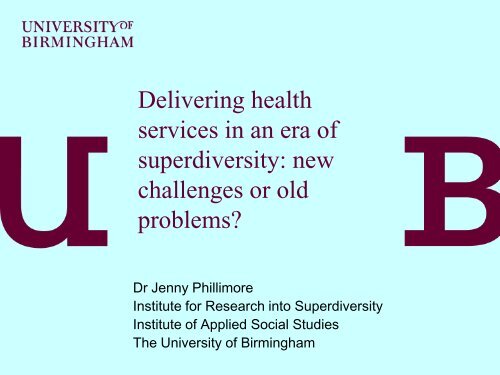View presentation slides (PDF) - University of Birmingham
View presentation slides (PDF) - University of Birmingham
View presentation slides (PDF) - University of Birmingham
You also want an ePaper? Increase the reach of your titles
YUMPU automatically turns print PDFs into web optimized ePapers that Google loves.
Delivering healthservices in an era <strong>of</strong>superdiversity: newchallenges or oldproblems?Dr Jenny PhillimoreInstitute for Research into SuperdiversityInstitute <strong>of</strong> Applied Social StudiesThe <strong>University</strong> <strong>of</strong> <strong>Birmingham</strong>
Introduction Superdiversity and welfare provision Superdiversity in the West Midlands Old problems and new challenges in healthprovision Newness and novelty A tentative way forward
Superdiversity “Diversification <strong>of</strong> diversity” (Vertovec 2007 Speed – 9% to 13% born overseas Scale – census – 3.5m rise in population 56%are migrants Spread – now urban and rural i.e. Bostonhighest increase in AoW (11.4%) Complexity – gender, status, age, reason formigration, class, faith....... Fragmentation – from many migrants from afew countries to a few from many Super-mobility
Superdiversity and access to welfare Emergence <strong>of</strong> superdiversity and globalneighbourhoods Social scientific and policy challenges (Vertovec2006) Viability <strong>of</strong> MC approaches to welfare deliveryquestioned (Ahmed & Craig 2003)– Politically (backlash, alleged loss <strong>of</strong> social solidarity)– Financially (austerity cuts)– Practically (weakness <strong>of</strong> ethnicity approach) Need for new models (Vertovec 2006) Focus on health provision in W. Midlands
The West Midlands
SD, migration, and health in West Midlands Central region, 2 nd biggest urban area, highdeprivation and rural remoteness <strong>Birmingham</strong> to become majority/minority city Migrants from 187 countries – old and newmigrants, clustered and fragmented (table) High levels <strong>of</strong> deprivation, exclusion, poorhealth outcomes and highest infant mortalityrates in Europe Is there a crisis in welfare delivery? Are there new challenges for providers?
Methods No reliable/complete socio demographic data Need to generate findings with policy relevanceto improve services Four research projects focusing on differentaspects <strong>of</strong> health (MH, maternity, primary care) Move from ethnicity sampling to SD sampling Selection on the basis <strong>of</strong> difference Questionnaires and interviews by communityresearchers with new migrants Interviews with health pr<strong>of</strong>essionals
Old problemsNew challengesMigrantsLanguage Initially Difficulty identifying translators/ interpreters forTransiencyPressure onservicesRights andentitlementsInability tounderstandinstitutionalcultureCultural needsnot metPopulations tended to be morefixedInitiallyFree access to NHS – assumed inthe UK legallyInitially“new” languages”Break in continuity <strong>of</strong> carePressure <strong>of</strong> numbers means limited GeneralPractitioner spacesOver-use <strong>of</strong> A&EEnd <strong>of</strong> free access - health problems neglecteduntil acuteOthers incorrectly denied free access“Misuse” <strong>of</strong> servicesInitially but later specialist For “old” migrants but not newservices developedDestitution No In hiding and no income so health seeking isIsolationNorestrictedFragmentation means lack <strong>of</strong> critical mass
LanguagesOld problemsProvidersInitially but eventuallyinterpretation and minority staffand development <strong>of</strong> expertiseNew challengesProblems accessing appropriatetranslation/ interpretation plus reducedbudgetsTransiency No Inability build relationships withpatients, new patients requiringintensive interventionLack <strong>of</strong> data Yes YesLack <strong>of</strong> knowledge Initially but over time knowledgeacquiredConstant newness and novelty mitigatesagainst development <strong>of</strong> knowledgeOutsourcing <strong>of</strong>immigration controlNoHealth providers have role inrestrictionalism and expected to denythose who can’t payDestitution No Charges for those with NRPFMultiple problems To some extent New levels <strong>of</strong> complexity as immigrationstatus interacts with ethnicity, language,culture etc
Discussion: newness and novelty Novelty– Novel language, culture and systems for migrants– Novel languages, cultures, immigration rules androles, and entitlements for pr<strong>of</strong>essionals– Novel encounters with diversity in rural (& urban)areas– Novel combinations <strong>of</strong> problems with no clear solution Newness– Lack <strong>of</strong> established community with collectiveknowledge to support or guide migrants– Patients always new when high levels <strong>of</strong> transiency:require extra time and admin costs– No opportunity to develop knowledge orexpertise
Discussion Scale <strong>of</strong> arrivals exceeds all previous experience Superdiversity treated as a problem to becontrolled at borders rather than a condition No funds, time or training to adjust NHS restructuring and austerity cuts leading to loss<strong>of</strong> expertise around old problemsConsequences: Migrants: over-use, misuse or don’t use system Pr<strong>of</strong>essionals: overwhelmed, confused andpowerless and sometimes resentful
What to do? Need to acknowledge new reality <strong>of</strong> SD Not practical/possible for pr<strong>of</strong>essionals toacquire comprehensive cultural knowledge oridentify interpreters for all Move from multicultural mindset tointerculturalism – make no assumptions Train all new pr<strong>of</strong>essionals in interculturalcommunication Educate children about institutional cultures New health intermediary role Invest to save????
Conclusion Social policy challenges associated with SD Repeating all <strong>of</strong> the old problems Experiencing many new problems associatedwith “super”- diversity, scale, speed andspread, complexity and fragmentation Much work is needed to :– Understand common and divergentchallenges– Identify innovative, sustainable and freesolutions






![Benyamin Asadipour-Farsani [EngD Conference abstract]](https://img.yumpu.com/51622940/1/184x260/benyamin-asadipour-farsani-engd-conference-abstract.jpg?quality=85)









